形容词词组、形容词的比较级和最高级
英语形容词的比较级和最高级整理

英语形容词的比较级和最高级整理常规:1、一般直接在词尾加er;est.tall---taller---the tallestgreat---greater---the greatest2、以字母e结尾的直接加r;stnice---nicer---the nicestfine---finer---the finest3、以辅音字母加y结尾的形容词变y为i再加er;estbusy---busier---the busiestheavy---heavier---the heaviest4、重读闭音节结尾的单音节词,若词尾只有一个辅音字母时,须双写这个辅音字母再加er;estbig-bigger-the biggesthot -hotter-the hottest5、少数以-y,-er,-ow,-ble结尾的双音节词,末尾加-er^D-est(以-y 结尾的词,如-y前是辅音字母,则变y为i,再加-er和-est;以-e 结尾的词仍只加-r和-st)happy—happier—happiestclever—cleverer—cleverest5、多音节和部分双音节词在词前加more、mosteasily--more easily--most easilybeautiful--more beautiful--the most beautiful特殊:(1 )有些单音节词的比较等级常用more和most,如glad,fond,shy,sly(但like 只可用more 和most)。
Eg:I am not more glad than you.我可没像你那样高兴。
Uncle Jack was more like a book of reference to my father.杰克大叔对我父亲来说真是一部参考书。
(2)有些单音节词用-er和-est或more和most皆可,如free,clear 等。
Eg:I'm clearer/more clear about it than before.对这事,我比以前更清楚了。
常用形容词的比较级和最高级
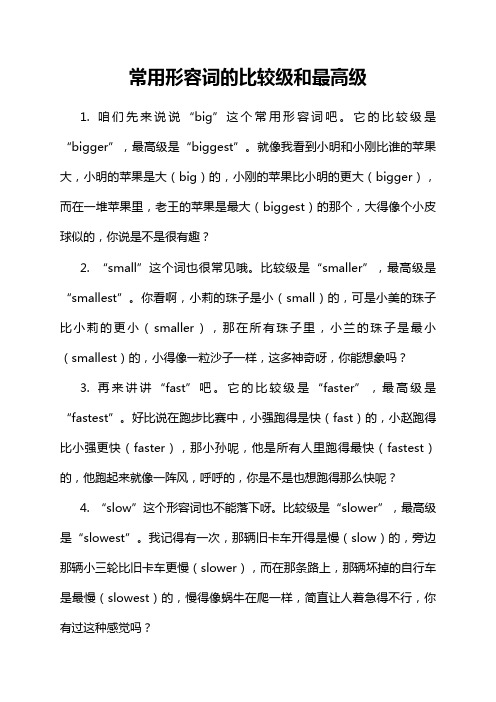
6. “short”也得好好唠唠。比较级是“shorter”,最高级是“shortest”。比如说小伟是矮(short)的,小邓比小伟更矮(shorter),在一群小朋友里,小韩是最矮(shortest)的,矮得像个小蘑菇,哈哈,是不是很可爱的形容呢?
2. “small”这个词也很常见哦。比较级是“smaller”,最高级是“smallest”。你看啊,小莉的珠子是小(small)的,可是小美的珠子比小莉的更小(smaller),那在所有珠子里,小兰的珠子是最小(smallest)的,小得像一粒沙子一样,这多神奇呀,你能想象吗?
3. 再来讲讲“fast”吧。它的比较级是“faster”,最高级是“fastest”。好比说在跑步比赛中,小强跑得是快(fast)的,小赵跑得比小强更快(faster),那小孙呢,他是所有人里跑得最快(fastest)的,他跑起来就像一阵风,呼呼的,你是不是也想跑得那么快呢?
9. “narrow”这个形容词也很常用呢。比较级是“narrower”,最高级是“narrowest”。就像这条小路是窄(narrow)的,那条小巷子比这条小路更窄(narrower),而山间的那条羊肠小道是最窄(narrowest)的,窄得只能一个人侧身通过,走在上面都有点害怕呢,你有走过这么窄的路吗?
我的观点结论就是:常用形容词的比较级和最高级在我们日常生活中的描述中非常有用,它们可以让我们把事物之间的差别更生动形象地表达出来,就像给我们的表达增添了魔法一样。
形容词的比较级和最高级大全

形容词的比较级和最高级大全以下是形容词的比较级和最高级的大全:1. 单音节形容词:比较级:在词尾加-er最高级:在词尾加-est例如:big - bigger (比较级)、biggest (最高级)2. 多音节形容词:比较级:在前面加more最高级:在前面加most例如:beautiful - more beautiful (比较级)、most beautiful (最高级)3. 不规则变化的形容词:比较级:在前面加more最高级:在前面加most例如:good - better (比较级)、best (最高级)4. 以y结尾的形容词:比较级:将y变成i,再加上-er最高级:将y变成i,再加上-est例如:happy - happier (比较级)、happiest (最高级)5. 以le结尾的形容词:比较级:在词尾加上-er最高级:在词尾加上-est例如:possible - more possible (比较级)、most possible (最高级)6. 少数不规则变化的形容词:比较级:在前面加more最高级:在前面加most例如:famous - more famous (比较级)、most famous (最高级)7. 特殊的比较级和最高级:例如:well - better (比较级)、best (最高级)8. 副词的比较级和最高级:比较级:在后面加-er最高级:在后面加-est例如:slowly - more slowly (比较级)、most slowly (最高级)以上是常见的形容词的比较级和最高级,但是也有一些不规则变化的形容词需要记忆。
同时,需要注意的是,有些形容词没有比较级和最高级,如unique。
形容词的比较级和最高级

变化规则大多数形容词和副词有比较级和最高级的变化,即原级、比较级和最高级,用来表示事物的等级差别。
原级即形容词的原形,比较级和最高级有规则变化和不规则变化两种。
(1)单音节词加词尾-er,-est来构成比较级和最高级。
tall(高的) taller tallestgreat(巨大的) greater greatest(2)以不发音的e结尾的单音节词只加-r,-stnice(好的) nicer nicestlarge(大的) larger largestable(有能力的) abler ablest(3)以一个辅音字母结尾的闭音节单音节词,双写结尾的辅音字母,再加-er,-estbig(大的) bigger biggesthot热的) hotter hottestred红色的redder reddest(4)"以辅音字母+y"结尾的双音节词,改y为i,再加-er,-esteasy(容易的) easier easiestbusy(忙的) busier busiest(5)以ly结尾的副词,除early-earlier-earliest,其他都是加more most.Slowly-more slowly-most slowlyBravely-more bravely-most bravelyquickly-more quickly-most quickly(6)少数以-er,-ow结尾的双音节词未尾加-er,-estclever(聪明的) cleverer cleverestnarrow(窄的) narrower narrowest(7)其他双音节词和多音节词在前面加more,most来构成比较级和最高级。
如:important(重要的) more important most importanteasily(容易地) more easily most easily(8)一些词的比较级和最高级,可以加-er或-est,也可以加more或most,如:clever, polite 等。
形容词的比较级与最高级详细讲解
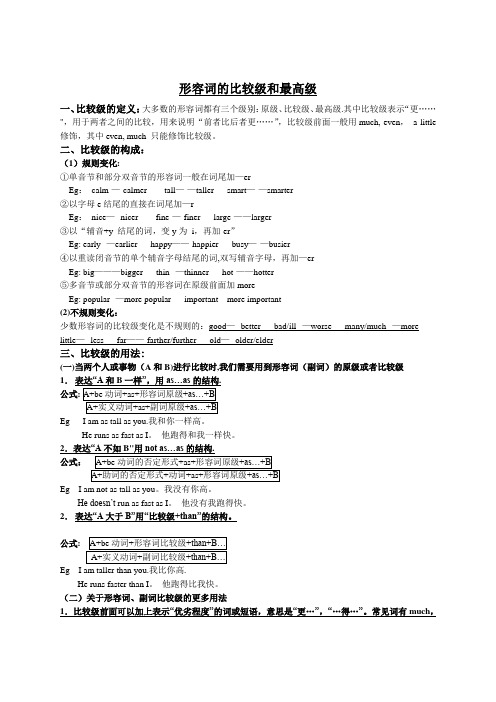
形容词的比较级和最高级一、比较级的定义:大多数的形容词都有三个级别:原级、比较级、最高级.其中比较级表示“更……",用于两者之间的比较,用来说明“前者比后者更……”,比较级前面一般用much, even,a little 修饰,其中even, much 只能修饰比较级。
二、比较级的构成:(1)规则变化:①单音节和部分双音节的形容词一般在词尾加—erEg:calm-—-calmer tall—-—taller smart—-—smarter②以字母e结尾的直接在词尾加—rEg:nice—--nicer fine-—-finer large-——larger③以“辅音+y 结尾的词,变y为i,再加-er”Eg: early--—earlier happy——-happier busy—-—busier④以重读闭音节的单个辅音字母结尾的词,双写辅音字母,再加—erEg: big———bigger thin--—thinner hot-——hotter⑤多音节或部分双音节的形容词在原级前面加moreEg: popular--—more popular important---more important(2)不规则变化:少数形容词的比较级变化是不规则的:good—--better bad/ill--—worse many/much--—more little—--less far——-farther/further old—--older/elder三、比较级的用法:(一)当两个人或事物(A和B)进行比较时,我们需要用到形容词(副词)的原级或者比较级1.表达“A和B一样”,用as…as的结构.公式Eg I am as tall as you.我和你一样高。
He runs as fast as I。
他跑得和我一样快。
Eg I am not as tall as you。
我没有你高。
He doesn’t run as fast as I。
形容词比较级和最高级

初二语法讲义形容词比较级和最高级1 构成方法:1)辅音+y的改y为i加er/est 2)大小胖瘦湿热悲红适合===双写最后一个字母3)多音节词或以ing, ed, ful, less, ly, ous结尾的加more,most构成good – better – best ill/bad/badly – worse – worst many/much – more – mostlittle – less – least far – farther – farthest(距离)/further - furthest(程度+距离)old-older-oldest(年龄)/elder-eldest(哥哥姐姐)2 注意点:1)两者之间用比较级,三者以上用最高级。
2)than+比较级,among, of, in+最高级,为免重复,常用one(s), that,those等词来替代前词。
3)A or B用比较级,A,B or C用最高级4)much, even, still, far, a little, a bit, a lot +比较级5)very, so, such, quite, too +原级,more,most +原级构成比较级和最高级6)比较级and 比较级====越来越taller and taller more and more important7) the+比较级,the+比较级==越--就越-- The harder you work, the better you’ll be.8) the +比较级+of the two,形容词最高级前+the,也可用形容词性物主代词(my best friend),副词最高级前可不+the,也可序数词+最高级,the second largest9)比较级+than any other +单数名词=比较级+than the other +复数名词=最高级+范围10)one of +the +最高级+复数名词11)可数名词前用few, a few, fewer, fewest, 不可数名词前用little, a little, less, least12) 形容词一般+ly构成副词,y结尾改为i+ly,e结尾直接+ly(除true—truly),le改lyTerrible-terribly, healthy-healthily, polite-politely13) 有些词既是adj又是adv,如:far, fast, hard, long, late, high, straight等, 但friendly, lovely, lonely, daily, weekly, monthly, yearly, deadly却是形容词14)as+adj/adv原级+as,not as/so---as 不如(注意应是同类事物比较,以及如何和比较级最高级转换)as---as possible 尽可能---反身代词固定词组(反身代词不可单独作主语,复数改f为ves)dress oneself 自己穿衣enjoy oneself 过的快活help oneself to 随便吃、随便用say to oneself 心里想say to oneself 自言自语teach oneself 自学=learn—by oneselffor oneself 为自己;亲自地by oneself 独自地; hurt oneself受伤; pull oneself up the rocks攀岩look after oneself照顾自己keep the secret to oneself保密祈使句1)肯定祈使句V原开头,回答(I will)否定祈使句Don’t/Never+V原(回答sorry, I won’t)2)人名,+祈使句let’s do/ let’s not do3)祈使句,and/or sb will/can do可于if从句转换Get up early, and you’ll catch the first bus.=If you get up early, you will get up the first bus.4)Should do/shouldn’t do/had better do/had better not do反义词的构成Helpful-helpless, careful-careless, useful-useless, cheerful-cheerless, hopeful-hopeless, meaningful-meaningless, tasteful-tasteless, endless, sleepless, noiseless,Certain-uncertain, comfortable-uncomfortable, important-unimportant, interesting-uninteresting able-unable, friendly-unfriendly, happy-unhappy, healthy-unhealthy, kind-unkind, lucky-unlucky Pleasant-unpleasant, tidy-untidy, usual-unusual, active-inactive, correct-incorrect, complete-incomplete, polite-impolite, patient-impatient, possible-impossible。
形容词副词比较级最高级变化形式归纳(超全)
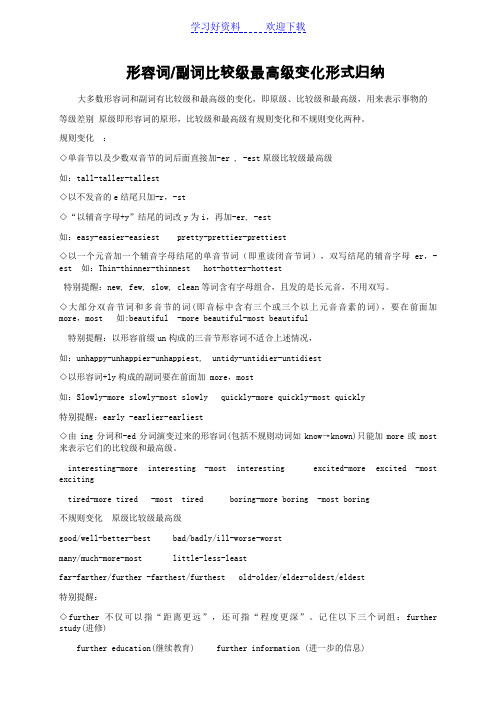
形容词/副词比较级最高级变化形式归纳大多数形容词和副词有比较级和最高级的变化,即原级、比较级和最高级,用来表示事物的等级差别原级即形容词的原形,比较级和最高级有规则变化和不规则变化两种。
规则变化:◇单音节以及少数双音节的词后面直接加-er , -est原级比较级最高级如:tall-taller-tallest◇以不发音的e结尾只加-r,-st◇“以辅音字母+y”结尾的词改y为i,再加-er, -est如:easy-easier-easiest pretty-prettier-prettiest◇以一个元音加一个辅音字母结尾的单音节词(即重读闭音节词),双写结尾的辅音字母er,-est 如:Thin-thinner-thinnest hot-hotter-hottest特别提醒:new, few, slow, clean等词含有字母组合,且发的是长元音,不用双写。
◇大部分双音节词和多音节的词(即音标中含有三个或三个以上元音音素的词),要在前面加more,most 如:beautiful -more beautiful-most beautiful特别提醒:以形容前缀un构成的三音节形容词不适合上述情况,如:unhappy-unhappier-unhappiest, untidy-untidier-untidiest◇以形容词+ly构成的副词要在前面加 more,most如:Slowly-more slowly-most slowly quickly-more quickly-most quickly特别提醒:early -earlier-earliest◇由ing分词和-ed分词演变过来的形容词(包括不规则动词如know→known)只能加more或most 来表示它们的比较级和最高级。
interesting-more interesting -most interesting excited-more excited -most excitingtired-more tired -most tired boring-more boring -most boring不规则变化原级比较级最高级good/well-better-best bad/badly/ill-worse-worstmany/much-more-most little-less-leastfar-farther/further -farthest/furthest old-older/elder-oldest/eldest特别提醒:◇further不仅可以指“距离更远”,还可指“程度更深”。
小学英语形容词的比较级和最高级-课件

多音节 词和部 分双音 节词
在词前加more或most
beautiful
more beautiful
most beautiful
interesting more interesting most interesting
二、不规则形容词的比较级最高级
fewest
词
尾
变 ta化ller h原ar级tdaellrest 比ha较rde最st高
单e-以个或以e少词rss音重辅e辅,tt或(数可s最节读音音t-以加高词闭字字e--see级在音母母trr,或)+词节应-以oy-w尾结双e结字s结加尾写尾母t 尾-的辅的ee的接词音词r(双尾比末字变音的较尾母为节词级只再i再加)有加la或加-re一bf-r-gar或immmegthetrgeaoooatlbtwhencwerrbhwprrraahlaaailehdeeeerrgoiwpliirirpetlgnvgedlmmmrncarlphteeyiasdpthoeirygheftlepratewaorleeoooaiowotereorrdfrpgsttttivsdsssfpsrrdestwditeiyoetettteetucrtrselrwfrspsdulincyetaaaetl级oillearotrfrtewtpfrrlwveiiruecioesldsulyrtwaetelrt级sestst t
2.以字母e 结尾的词只加-r或- st构成比较 级和最高级。
nice fine white
nicer finer whiter
nicest finest whitest
3.重读闭音节以一个辅音字母结尾的,应先 双写辅音字母,再加-er 或-est.
形容词、副词比较级和最高级的构成及用法

格式: much+ 副词比较级+than
例句: Can Kim run faster than Jim? Sue goes to the movies much more than I do. Today the water in the river is flowing slower than
yesterday. Today Amy arrived at the school earlier than me.
5.无比较级的形容词
right wrong perfect excellent
有些词本身含有比较含义,也没有比较级:
senior(年长的) junior(年小的) major(主要的) minor(次要的)
提示:避免双重比较
cheaper more cheaper
better more better
Lee is a better student than me.=Lee is a better student than I am. I'm healthier than her.=I'm healthier than she is.
格式: the+形容词最高级
例句: Which girl is the tallest,Liz,Jane or Jill? Mr.Wood is the friendliest person in our neighborhood. Lisa is the fastest swimmer on our swimming team. She is the most hardworking student I've ever known.
单音节的形容词+er/est
常见形容词的比较级和最高级有哪些
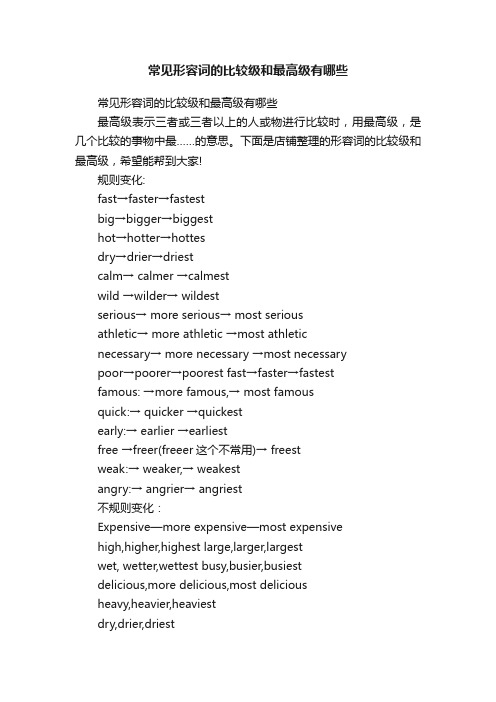
常见形容词的比较级和最高级有哪些常见形容词的比较级和最高级有哪些最高级表示三者或三者以上的人或物进行比较时,用最高级,是几个比较的事物中最……的意思。
下面是店铺整理的形容词的比较级和最高级,希望能帮到大家!规则变化:fast→faster→fastestbig→bigger→biggesthot→hotter→hottesdry→drier→driestcalm→ calmer →calmestwild →wilder→ wildestserious→ more serious→ most seriousathletic→ more athletic →most athleticnecessary→ more necessary →most necessarypoor→poorer→poorest fast→faster→fastestfamous: →more famous,→ most famousquick:→ quicker →qu ickestearly:→ earlier →earliestfree →freer(freeer这个不常用)→ freestweak:→ weaker,→ weakestangry:→ angrier→ angriest不规则变化:Expensive—more expensive—most expensivehigh,higher,highest large,larger,largestwet, wetter,wettest busy,busier,busiestdelicious,more delicious,most deliciousheavy,heavier,heaviestdry,drier,driesteasy easier easiestlazy lazier laziestpretty prettier prettiestnaughty naughtier naughtiestmealy mealier mealiestearly earlier earliestthirsty thirstier thirstiestfar→farther→farthestfar→further→furthestDull—duller--dullestLoud-louder--loudestBoring—more boring—most boringCreative—more creative—most creativeWarm---warmer--warmestgood / well→better→bestbad / ill→worse→worstmany / much→more→mostlittle→less→leastlate→later→ / latestlate→latter→last【拓展】关于形容词和副词的比较级一、含义1. 大多数形容词和副词有三个等级:原级、比较级、最高级: good – better - best2. 比较级:表示两者(人或物)之间的比较。
形容词的比较级与最高级的例词

形容词的比较级与最高级的例词形容词是用来描述人、事物、情感和行为特征的词语,而形容词的比较级和最高级则是用来对不同事物或人的特征进行比较和排序。
在英语中,形容词的比较级和最高级有一定的构造规则和用法。
下面将以几个常见的形容词为例,详细介绍形容词的比较级和最高级。
1. Tall(高):- 比较级:taller(更高的)- 最高级:tallest(最高的)举例:- My brother is taller than me.(我的哥哥比我高)- John is the tallest student in our class.(约翰是我们班最高的学生)2. Bright(明亮的):- 比较级:brighter(更明亮的)- 最高级:brightest(最明亮的)举例:- The sun is brighter than the moon.(太阳比月亮更明亮)- This room has the brightest light.(这个房间有最亮的光线)3. Fast(快的):- 比较级:faster(更快的)- 最高级:fastest(最快的)举例:- The cheetah is faster than any other animal.(猎豹是比其他动物都更快的)- Usain Bolt is the fastest sprinter in the world.(尤塞恩·博尔特是世界上最快的短跑运动员)4. Delicious(美味的):- 比较级:more delicious(更美味的)- 最高级:most delicious(最美味的)举例:- The cake is more delicious than the cookies.(蛋糕比饼干更美味)- This restaurant serves the most delicious food in town.(这家餐厅提供镇上最美味的食物)5. Interesting(有趣的):- 比较级:more interesting(更有趣的)- 最高级:most interesting(最有趣的)举例:- The book is more interesting than the movie.(这本书比电影更有趣)- The history museum was the most interesting place we visited.(历史博物馆是我们参观的最有趣的地方)通过上述例子,我们可以看到形容词的比较级和最高级的构造方式。
英语中的形容词有哪些比较级和最高级

英语中的形容词有哪些比较级和最高级?英语中的形容词比较级和最高级通常是通过在形容词前加上不同的前缀来构成的。
以下是常见的形容词比较级和最高级形式:1. 一般形式:形容词的原级(Positive Degree)是形容词的基本形式,用于描述事物的基本特征。
例如:big(大)、beautiful(美丽)、fast(快)等。
2. 比较级(Comparative Degree):用于比较两个事物的性质、大小、品质等。
形成比较级的一般规则是在形容词前加上"-er"或者在形容词前加上"more"。
例如:- big(大)- bigger(更大)- beautiful(美丽)- more beautiful(更美丽)- fast(快)- faster(更快)3. 最高级(Superlative Degree):用于比较三个或更多事物之间的性质、大小、品质等,表示最高程度。
形成最高级的一般规则是在形容词前加上"-est"或者在形容词前加上"most"。
例如:- big(大)- biggest(最大)- beautiful(美丽)- most beautiful(最美丽)- fast(快)- fastest(最快)需要注意的是,有些形容词的比较级和最高级形式是不规则的,需要记住其特殊形式。
例如:- good(好)- better(更好)- best(最好)- bad(坏)- worse(更坏)- worst(最坏)- much(多)- more(更多)- most(最多)以上是英语中常见的形容词比较级和最高级形式。
掌握这些形式可以帮助我们在表达时更准确地描述事物的特征和进行比较。
中考英语语法专题形容词的比较级和最高级

中考英语语法专题形容词的比较级和最高级中考英语语法专题形容词的比较级和最高级形容词的比较级和最高级3) 有几个形容词的比较级和最高级属于不规则变化。
原级比较级最高级good/well 好的 better bestbad/ill 坏的 worse worstmany/much 多的little 少的 less leastfar 远的 further furthestfarther farthestold 老的 older oldestelder eldest2. 形容词比较级的用法1)形容词的比较级可以单独使用:Bareful nex下次小心点。
It was quieter outside. 外面安静点了。
It couldn’t be easier. 不能再容易了。
This caxpensive. 这辆车比较贵。
Who is taller? 谁高一点?Which book is better? 哪本书更好?1. 形容词比较级和最高级的构成1)单音节词和少数双音节词的比较级和最高级的构成2) 多音节词和部分双音节词在其前面加more或most。
如:原级比较级最高级useful more useful most usefuldifficult more difficult most difficultdelicious more delicious most delicious2)也可以和than连用,表示两者相比,than后可以跟:a. 名词或代词(若为人称代词,在口语中多用宾格):He is older than me. 他年龄比我大。
Tbigger than New York. 东京比纽约大。
b. 动名词:Skiingxciting than skating. 滑雪比滑冰更刺激。
Tg thag in a这比坐办公室更有意思。
c. 从句:I was a bger than he was. 我唱歌比他好。
形容词的比较级和最高级的构成方式

形容词的比较级和最高级的构成方式形容词是用来描述人、事物或情况的词语,而比较级和最高级则用于比较不同事物之间的程度、大小或其他属性。
形容词的比较级和最高级有各自不同的构成方式。
一、比较级的构成方式1. 单音节形容词:直接在形容词后面加上-er,如:tall(高)→ taller(更高)。
否定形式为在形容词前加上less,如:less tall(不如高)。
2. 以-e结尾的形容词:直接在形容词后面加上-r,如:large(大)→ larger(更大)。
否定形式为在形容词前加上less,如:less large(不如大)。
3. 以辅音字母+y结尾的形容词:先将y改为i,再加上-er,如:heavy(重)→ heavier(更重)。
否定形式为在形容词前加上less,如:less heavy(不如重)。
4. 多音节形容词:在形容词前加上more,如:beautiful(美丽)→ more beautiful(更美丽)。
否定形式为在形容词前加上less,如:less beautiful(不如美丽)。
5. 不规则比较级形式:存在一些形容词比较级的构成方式不规则,需进行记忆,如:good(好)→ better(更好)。
否定形式为在形容词前加上less,如:less good(不如好)。
二、最高级的构成方式1. 单音节形容词:在形容词前加上the,然后加上-est,如:tall(高)→ the tallest(最高)。
否定形式为在the前加上least,如:the least tall(最不高)。
2. 以-e结尾的形容词:在形容词前加上the,然后加上-st,如:large(大)→ the largest(最大)。
否定形式为在the前加上least,如:the least large(最不大)。
3. 以辅音字母+y结尾的形容词:先将y改为i,再加上-est,如:heavy(重)→ the heaviest(最重)。
形容词比较级和最高级more,most

形容词比较级和最高级more, most最高级是英语语法常用的简单的但是又能显示出英语实力的知识,作文里多用这个能提分。
小编在这里整理了相关知识,快来学习学习吧!形容词比较级和最高级more, most形容词比较级和最高级的规则变化2.形容词比较级和最高级more, most形式。
大多数双音节、三音节以及三音节以上的形容词采用“more+原级”构成比较级形式,“most+原级”构成最高级形式。
如下:2.1一般双单音节形容词careful原级→more careful比较级→most careful最高级active原级→more active比较级→most active最高级useful原级→more useful比较级→most useful最高级2.2三单音节以及三音节以上的形容词difficult原级→more difficult比较级→most difficult最高级interesting原级→more interest ing比较级→most interesting 最高级2.3-ed结尾的形容词tired原级→more tired比较级→most tired最高级worried原级→more worried比较级→most worried最高级欢迎转发~~~发动大家来做作业,学英语~英语作业20180413一、选择填空35.—How do you get to your office every day? Do you walk?—It’s ___ far to walk. I’lltake the subway.A.soB.quiteC.tooD.still36.—Are you leaving for home soon?—Oh,I’ve ___ got a few days in Shanghai. I haven’t finishedmy job here ___.A.still, yetB.already, nearlyC.still, alreadyD.yet, almost上一期英语作业20180412参考答案:33-34:BB二、分析句子的英语语法结构,并翻译成中文RAF Akrotiri in Cyprus is at the sharp end of the British military presence in the eastern Mediterranean. Rumour is rife on the island that the installation would be targeted if Russia were to retaliate in the event of US-led military action in Syria.【卫报The Guardian】高一英语必修一必背句型1) It was the first time in a year and a half that I had seen the night face to face. (从句时态用完成时) 这是我一年半以来第一次目睹夜晚。
形容词的比较级和最高级

形容词的比较级和最高级形容词的比较级和最高级一、比较级1.定义:比较级是用来比较两个事物之间的差异或程度。
通常,我们使用形容词的比较级来表示“更”或“较”的概念。
2.构成规则:大多数形容词的比较级可以通过加-er后缀来构成。
例如:good - betterbad - worseold - older3. 使用方法:在句子中,比较级通常与than或than any other +单数名词连用。
例如:John is younger than his brother. 约翰比他的哥哥年轻。
Jane is more intelligent than anyone else in the class. 简比班上其他任何人都聪明。
二、最高级1.定义:最高级用于描述一个事物在特定范围内是最高或最大的。
2.构成规则:大多数形容词的最高级可以通过加-est后缀来构成。
例如:good - bestbad - worstold - oldest3. 使用方法:在句子中,最高级通常与of all或in + 范围连用。
例如:Tom is the tallest in his class. 汤姆是他们班上最高的。
Jane is the most intelligent student in the class. 简是班上最聪明的学生。
练习:请根据所给答案纠正你的错误,并重新做一遍。
1.She sings ___in her class. (beautiful)2.答案:best3.He is ___than his brother. (tall)4.答案:taller5.This book is ___than that one. (interesting)6.答案:more interesting7.The ___of all the cars here is the red one. (beautiful)8.答案:most beautiful9.She studies harder than any other student ___class. (in)。
形容词的比较级和最高级
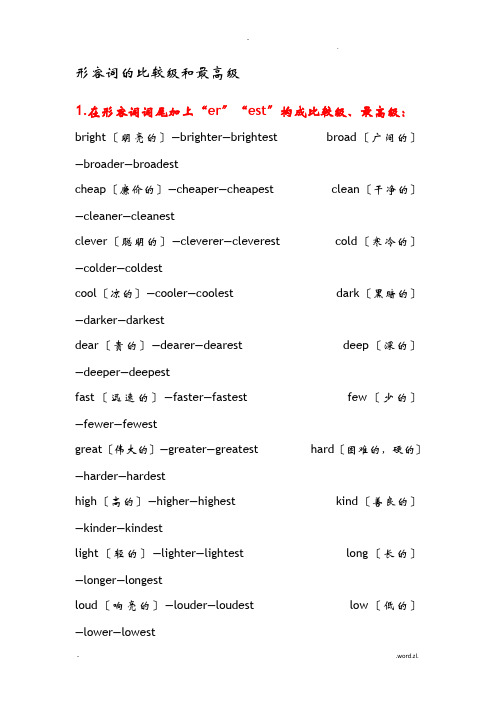
形容词的比较级和最高级1.在形容词词尾加上“er〞“est〞构成比较级、最高级:bright〔明亮的〕—brighter—brightest broad〔广阔的〕—broader—broadestcheap〔廉价的〕—cheaper—cheapest clean〔干净的〕—cleaner—cleanestclever〔聪明的〕—cleverer—cleverest cold〔寒冷的〕—colder—coldestcool〔凉的〕—cooler—coolest dark〔黑暗的〕—darker—darkestdear〔贵的〕—dearer—dearest deep〔深的〕—deeper—deepestfast〔迅速的〕—faster—fastest few〔少的〕—fewer—fewestgreat〔伟大的〕—greater—greatest hard〔困难的,硬的〕—harder—hardesthigh〔高的〕—higher—highest kind〔善良的〕—kinder—kindestlight〔轻的〕—lighter—lightest long〔长的〕—longer—longestloud〔响亮的〕—louder—loudest low〔低的〕—lower—lowestnear〔近的〕—nearer—nearest new〔新的〕—newer—newestpoor〔穷的〕—poorer—poorest quick〔快的〕—quicker—quickestquiet〔安静的〕—quieter—quietest rich〔富裕的〕—richer—richestshort〔短的〕—shorter—shortest slow〔慢的〕—slower—slowestsmall〔小的〕—smaller—smallest smart〔聪明的〕—smarter—smartestsoft〔柔软的〕—softer—softest strong〔强壮的〕—stronger—strongestsweet〔甜的〕—sweeter—sweetest tall〔高的〕-taller-tallestthick〔厚的〕—thicker—thickest warm〔温暖的〕—warmer—warmestweak〔弱的〕—weaker—weakest young〔年轻的〕—younger—youngest2.双写最后一个字母,再加上“er〞“est〞构成比较级、最高级:big〔大的〕—bigger—biggest fat〔胖的〕—fatter—fattest hot〔热的〕—hotter—hottest red〔红的〕—redder—reddest sad〔伤心的〕—sadder—saddest thin〔瘦的〕—thinner—thinnestwet〔湿的〕—wetter—wettest mad〔疯的〕—madder—maddest3.以不发音的字母e结尾的形容词,加上“r〞“st〞构成比较级、最高级:able〔能干的〕—abler—ablest brave〔勇敢的〕—braver—bravestclose〔接近的〕—closer—closest fine〔好的,完美的〕—finer—finestlarge〔巨大的〕—larger—largest late〔迟的〕—later—latestnice〔好的〕—nicer—nicest ripe〔成熟的〕—riper—ripestrude〔粗鲁的〕—ruder—rudest safe〔平安的〕—safer—safeststrange〔奇怪的〕—stranger—strangest wide〔宽广的〕—wider—widestwise〔睿智的,聪明的〕—wiser—wisest white〔白的〕—whiter—whitest4.以字母y结尾的形容词,把y改为i,再加上“er〞“est〞构成比较级、最高级:busy〔忙碌的〕—busier—busiest dirty〔脏的〕—dirtier—dirtiestdry〔枯燥的〕—drier—driest early〔早的〕—earlier—earliesteasy〔容易的〕—easier—easiest friendly〔友好的〕—friendlier—friendliestfunny〔好玩的〕—funnier—funniest happy〔开心的〕—happier—happiesthealthy〔安康的〕—healthier—healthiest heavy〔重的〕—heavier—heaviesthungry〔饿的〕—hungrier—hungriest lazy〔懒惰的〕—lazier—laziestlucky〔幸运的〕—luckier—luckiest naughty〔淘气的〕—naughtier—naughtiestnoisy〔嘈杂的〕—noisier—noisiest pretty〔美丽的〕—prettier—prettiestsilly〔傻的〕—sillier—silliest spicy〔辣的〕—spicier—spiciestthirsty〔渴的〕—thirstier—thirstiest ugly〔丑的〕—uglier—ugliest5.双音节、多音节形容词,在单词前面加上“more〞“most〞构成比较级、最高级:afraid〔害怕的〕—more afraid—most afraidbeautiful〔美丽的〕—more beautiful—most beautifulcareful〔仔细的〕—more careful—most carefulcheerful〔开心的〕—more cheerful—most cheerfulcrowded〔拥挤的〕—more crowded—most crowdeddangerous〔危险的〕—more dangerous—most dangerous delicious〔美味的〕—more delicious—most deliciousdifficult〔困难的〕—more difficult—most difficultexciting〔令人兴奋的〕—more exciting—most exciting expensive〔昂贵的〕—more expensive—most expensivefamous〔著名的〕—more famous—most famousfrightened〔受惊的〕—more frightened—most frightened frightening〔令人害怕的〕—more frightening—most frightening hard-working〔勤奋的〕—more hard-working—most hard-working helpful〔有帮助的〕—more helpful—most helpfulhonest〔老实的〕—more honest—most honestimportant〔重要的〕—more important—most important interesting〔有趣的〕—more interesting—most interestingpolite〔有礼貌的〕—more polite—most politeterrible〔可怕的〕—more terrible—most terribletired〔累的〕—more tired—most tired6.不规那么变化的形容词:bad〔坏的〕—worse—worst far〔远的〕—farther—farthest(far—further—furthest)good〔好的〕—better—best ill〔病的〕—worse—worstlittle〔少的〕—less—least many〔多的〕—more—most much 〔多的〕—more—mostold〔年老的〕—older—oldest ( old—elder—eldest) well〔好的,身体好的〕—better—best。
- 1、下载文档前请自行甄别文档内容的完整性,平台不提供额外的编辑、内容补充、找答案等附加服务。
- 2、"仅部分预览"的文档,不可在线预览部分如存在完整性等问题,可反馈申请退款(可完整预览的文档不适用该条件!)。
- 3、如文档侵犯您的权益,请联系客服反馈,我们会尽快为您处理(人工客服工作时间:9:00-18:30)。
形容词及形容词词组概述:形容词(adjective简称adj.或a.) 很多语言中均有的主要词类中的一种。
主要用来修饰名词的词,表示事物的特征。
形容词用来修饰名词或代词,表示人或事物的性质,状态,和特征。
重点:形容词的用法难点:形容词的位置内容:一、形容词分类形容词是一种开放词类,在句中主要作修饰成分。
形容词主要分为单词形容词,等级形容词和非等级形容词。
1.依词的构成划分:单词形容词(One-word Adjective)和复合形容词(Compound Adjective)由一个自由词素构成,如:boy, kind1)单词形容词自由词素+前(后)缀构成,如:boyish, unkindadj.+adj. red-hot 炽热的;dark-green深绿色的adj./adv.+-ing easy-going随和的;good-looking好看的adj./adv.+-ed new-born新生的;ready-cooked烧好的2)复合形容词n.+adj. sea-sick晕船的;ice-cold冰冷的n.+-ing man-eating吃人的;epoch-making划时代的n.+-ed heart-broken伤心的;ice-covered结冰的adj.+n.+-ed gray-haired白发的;one-eyed独眼的2. 依句法功能划分:中心形容词(Central Adjective)和外围形容词(PeripheralAdjective)1)中心形容词:既能作名词修饰语又能作主补和宾补的形容词e.g. Green apples are sour (作名词修饰语)Pillar-boxes are green. (作主语补语)They have painted the windows green. (作宾语补足语)2)外围形容词:只能作修饰语或者只能作补语的形容词。
如,utter只能作修饰语不能作补语:This is utter nonsense. (√)The nonsense is utter. (×)又如asleep只能作补语不能作修饰语:This child is asleep. (√)This is an asleep child. (×)3. 依词汇意义划分:动态形容词(Dynamic Adjective)和静态形容词(Stative Adjective)1)静态形容词:描写人或物的静态特征,如,tall, short, small, big, beautiful, ugly等,大多数形容词都是静态形容词。
2)动态形容词:含有动作含义,如,clever, cheerful, dull, gentle, generous, helpful, patient, witty, etc.3)动态形容词和静态形容词的特征对比:①动态形容词可与动be的进行体搭配作补语,而静态形容词则不可以。
e.g. She is being witty. (√)She is being tall. (×)②动态形容词可用于由动词be开始的祈使句,而静态形容词则不可以。
e.g. Be patient! (√)Be pretty. (×)③动态形容词可用于使役结构(Caustative Construction),而静态形容词则不可以。
e.g. I persuaded her to be generous. (√)I persuaded her to be pretty. (×)二、形容词的功能1.作定语形容词作定语一般修饰名词,形容词通常前置,但有时也可后置,如:It was a rainy day.Someone else has done it.1)前置定语当名词中心词前出现几个属于不同层次的形容词作修饰语时,常常涉及词序问题,排列顺序大致如下:①可以置于冠词前的形容词:all, both, such等;②冠词、指示代词、所有格形容词、不定形容词:a, an, the, this, those,your, his, our, any, some等;③序数词:first, second, third等;④基数词:one, two, three等;表示⑤性质、状态、质量的形容词:nice, good, sweet, useful等;⑥表示大小、长短、形状的形容词:big, small, square, round 等;⑦表示年龄、新旧、温度的形容词:young, new, old, cold, hot等;⑧表示颜色的形容词:blue, white, brown等;⑨表示国籍、产地、区域的形容词:Chinese, American等;⑩表示材料、用作形容词的名词:iron, oil, stone, silk等;⑾分词:floating, handmade等(口诀:all等代冠数前置,描大形新颜国材)e.g. a large antique brown and white German beer-mug译:一只德国古代棕白两色的大啤酒杯a weak small spare old man 一个瘦弱的小老头a well-known German medical school 一所著名的德国医学院an interesting little red French oil painting一幅有趣的小型法国油画his first two interesting little red French oil paintings他的前两幅有趣的小型法国油画Ex. Radio, television and press_______ of conveying news as information.A) are the most three common meansB) are the most three common meansC) are the three most common meansD) are three the most common means2)后置定语形容词作定语一般位于所修饰的名词前,但是在下列情况下作定语的形容词却要位于所修饰的名词之后:①形容词短语作定语时要后置。
如:I think he is a man suitable for the job. 我认为他是适合做这项工作的人。
We need a place twice larger than this one. 我们需要一个比这里大一倍的地方。
②表语形容词作定语要后置。
如:He spoke like a man afraid. 他说话时像是很害怕似的。
He must be the best violinist alive. 他一定是当代最好的小提琴手了。
③受修饰复合不定代词时后置。
如:Tell me something interesting. 给我说些有意思的事。
Anyone intelligent can do it. 任何有头脑的人都能做这件事。
2.作补语形容词作主语补足语和宾语补足语时,可以表示其现状、状态,也可以表示某一动作的结果(如knock sb. Senseless), 并常用在表示“认为,看待”的动词如believe, prove, consider 等后。
例如:The news made her very sad. (宾语补足语)He died young. (主语补足语)The bottle was found empty. (主语补足语)The facts proved his accusation groundless.(宾语补足语)3.作状语形容词(短语)可作状语,其位置可以是举手、句中和句末;形容词作状语时,可以看作是“being+形容词”结构或when、if、because等从句的省略,表示时间、方式、原因、伴随、让步、强调、条件等,或对主语进行解释,说明主语是什么一种情况;或进行强调。
例如:Ripe, the oranges will sell at a good price.(时间)Alice tiptoed to the bed, careful not to wake the baby.(方式)Eager to see the sunrise, they got up at four.(原因)Breathless, she rushed in through the back door.(伴随情况)Large or small, all countries are equal.(让步)John is big and busy.(强调,=very busy)形容词一般用在系动词be后作表语,如:The bird’s song is very sweet.在下列三类系动词或感官动词后,要用形容词作表语,不可用副词。
1)表示“是、在”的动词要求用形容词作表语remain, keep持续在,continue继续在,stay保持,stand,lie位于等。
He remained silent at the meeting.2)表示“变成,成为”的动词要求用形容词作表语grow, turn, get变成,run很快变成,come果然变成,等。
Her dream has come true.(不可用truly)3)感觉、感官动词要求用形容词作表语see, appear, look, sound, smell, taste, feel等。
It sounds nicely. (×)It sounds nice. (√)He looked angrily at him. (×)He looked angry. (√)5.作主语1)形容词可以用作主语,往往成对使用,具有名词化的特点。
Old and young joined in the discussion.Rich or poor meant the same to him.Careful and careless are as different as fire and water.2)某些形容词加上定冠词可以泛指一类人,与谓语动词的复数连接。
如:the dead,the living,the rich,the poor,the blind,the hungryThe poor are losing hope.3)有关国家和民族的形容词加上定冠词指这个民族的整体,与动词的复数连用。
The Englis h have wonderful sense of humor.【注】形容词还可用作宾语They can’t tell right from wrong.Children should be taught to know good from wrong.有些形容词可用作感叹语,表示某种情绪。
